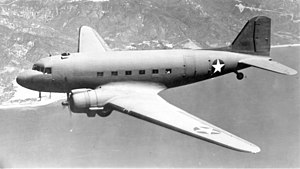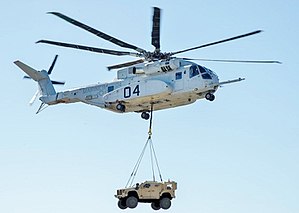Military transport aircraft
This article needs additional citations for verification. (August 2017) |
A military transport aircraft, military cargo aircraft or airlifter is a military-owned transport aircraft used to support military operations by airlifting troops and military equipment. Transport aircraft are crucial to maintaining supply lines to forward bases that are difficult to reach by ground or waterborne access, and can be used for both strategic and tactical missions. They are also often used for civilian emergency relief missions by transporting humanitarian aid.
Air frames
Fixed-wing

Fixed-wing transport aeroplanes are defined in terms of their range capability as strategic airlift or tactical airlift to reflect the needs of the land forces which they most often support. These roughly correspond to the commercial flight length distinctions: Eurocontrol defines short-haul routes as shorter than 1,500 km (810 nmi), long-haul routes as longer than 4,000 km (2,200 nmi) and medium-haul between.[1]
The military glider is an unpowered tactical air transport which has been used in some campaigns to transport troops and/or equipment to the battle front.
Rotary wing
Military transport helicopters are used in places where the use of conventional aircraft is impossible. For example, the military transport helicopter is the primary transport asset of US Marines deploying from LHDs and LHA. The landing possibilities of helicopters are almost unlimited, and where landing is impossible, for example densely packed jungle, the ability of the helicopter to hover allows troops to deploy by abseiling and roping.
Transport helicopters are operated in assault, medium and heavy classes. Air assault helicopters are usually the smallest of the transport types, and designed to move an infantry squad or section and their equipment. Helicopters in the assault role are generally armed for self-protection both in transit and for suppression of the landing zone. This armament may be in the form of door gunners, or the modification of the helicopter with stub wings and pylons to carry missiles and rocket pods. For example, the Sikorsky S-70, fitted with the ESSM (External Stores Support System), and the Hip E variant of the Mil Mi-8 can carry as much disposable armament as some dedicated attack helicopters.
Medium transport helicopters are generally capable of moving up to a platoon of infantry, or transporting towed artillery or light vehicles either internally or as underslung roles. Unlike the assault helicopter they are usually not expected to land directly in a contested landing zone, but are used to reinforce and resupply landing zones taken by the initial assault wave. Examples include the unarmed versions of the Mil Mi-8, Super Puma, CH-46 Sea Knight, and NH90.
Heavy lift helicopters are the largest and most capable of the transport types, currently limited in service to the CH-53 Sea Stallion and related CH-53E Super Stallion, CH-47 Chinook, Mil Mi-26, and Aérospatiale Super Frelon. Capable of lifting up to 80 troops and moving small Armoured fighting vehicles (usually as slung loads but also internally), these helicopters operate in the tactical transport role in much the same way as small fixed wing turboprop air-lifters. The lower speed, range and increased fuel consumption of helicopters are more than compensated by their ability to operate virtually anywhere.
Military transport aircraft
| Aircraft | Country | Payload (t) | Max takeoff weight | Cargo hold Length | Cargo hold Width | Cargo hold Height |
|---|---|---|---|---|---|---|
| Antonov An-124 | 150 | 402,000 kg (886,000 lb) | 36 m (118 ft) | 6.4 m (21 ft) | 4.4 m (14 ft) | |
| Lockheed C-5 Galaxy | 129.274 | 381,018 kg (840,001 lb) | 37 m (121 ft) | 5.8 m (19 ft) | 4.1 m (13 ft) | |
| Antonov An-22[2] | 80 | 250,000 kg (550,000 lb) | 32.7 m (107 ft) | 4.44 m (14.6 ft) | 4.44 m (14.6 ft) | |
| Boeing C-17[3] | 77.5 | 265,352 kg (585,001 lb) | 26.83 m (88.0 ft) | 5.49 m (18.0 ft) | 3.76 m (12.3 ft) | |
| Xi'an Y-20 | 66 | 220,000 kg (490,000 lb) | 20 m (66 ft) | 4 m (13 ft) | 4 m (13 ft) | |
| Ilyushin Il-76 | 60 | 190,000 kg (420,000 lb) | 24.54 m (80.5 ft) | 3.45 m (11.3 ft) | 3.4 m (11 ft) | |
| Antonov An-70 | 47 | 145,000 kg (320,000 lb) | 19.1 m (63 ft) | 4 m (13 ft) | 4.1 m (13 ft) | |
| Airbus A330 MRTT[4] | 45 | 233,000 kg (514,000 lb) | 45 m (148 ft) | 5.28 m (17.3 ft) | 2.54 m (8.3 ft) | |
| Airbus A400M | 37 | 141,000 kg (311,000 lb) | 17.71 m (58.1 ft) | 4 m (13 ft) | 3.85 m (12.6 ft) rear section:4 m (13 ft) | |
| Kawasaki C-2 | 36 | 141,000 kg (311,000 lb) | 16 m (52 ft) | 4 m (13 ft) | 4 m (13 ft) | |
| Embraer C-390 | 26 | 86,999 kg (191,800 lb) | 18.5 m (61 ft) | 3.00 m (9.84 ft) | 3.04 m (10.0 ft) | |
| Shaanxi Y-9[5] | 25 (30 max) | 65,000 kg (143,000 lb) | 16.2 m (53 ft) | 3.20 m (10.5 ft) | 2.35 m (7.7 ft) | |
| Mil Mi-26[6] | 20 | 56,000 kg (123,000 lb) | 12 m (39 ft) | 3.3 m (11 ft) | 2.9 m (9.5 ft) | |
| Lockheed Martin C-130J[3] | 19.8 | 70,370 kg (155,140 lb) | 12.5 m (41 ft) | 3.05 m (10.0 ft) | 2.75 m (9.0 ft) | |
| Antonov An-178 | 16 (18 max) | 51,000 kg (112,000 lb) | 13.21 m (43.3 ft) | 2.73 m (9.0 ft) | 2.73 m (9.0 ft) | |
| Transall C-160 | 16 | 51,000 kg (112,000 lb) | 17.20 m (56.4 ft) | 3.15 m (10.3 ft) | 2.98 m (9.8 ft) | |
| Sikorsky CH-53K | 15.876 | 39,916 kg (88,000 lb) | 9.14 m (30.0 ft) | 2.46 m (8.1 ft) | 2 m (6.6 ft) | |
| Alenia C-27J Spartan[7] | 11.6 max | 32,500 kg (71,700 lb) | 11.43 m (37.5 ft) | 3.33 m (10.9 ft) | 2.59 m (8.5 ft) | |
| Boeing CH-47 Chinook[8] | 10.886 | 22,680 kg (50,000 lb) | 9.14 m (30.0 ft) | 2.53 m (8.3 ft) | 1.98 m (6.5 ft) | |
| Antonov An-132[9] | 9.2 | 28,500 kg (62,800 lb) | 13.45 m (44.1 ft) | 1.81 m (5.9 ft) | 2.4 m (7.9 ft) | |
| Airbus C295 | 7 (9.25 max) | 23,200 kg (51,100 lb) | 12.69 m (41.6 ft) | 2.7 m (8.9 ft) | 1.9 m (6.2 ft) |
See also
References
- ^ "Study into the impact of the global economic crisis on airframe utilisation" (PDF). Eurocontrol. January 2011. p. 21.
- ^ "Antonov An-22". Aerocorner. Retrieved 3 November 2021.
- ^ a b "Comparison of military transport aircraft". theaviationzone.com. Retrieved 15 August 2021.
- ^ "Airbus A330 MRTT". Aerocorner. Retrieved 3 November 2021.
- ^ %5b%5bFile:Flag of the People's Republic of China.svg|23x15px|border |alt=|link=%5d%5d %5b%5bChina|People's Republic of China%5d%5d/y-9.htm "Shaanxi Y-9 (Yun-9)".
{{cite web}}: Check|url=value (help) - ^ "Mi-26 HALO". Federations of American Scientists - Military Analysis Network. Retrieved 3 November 2021.
- ^ "C-27J Capabilities and Cost Analysis Report" (PDF). wildfiretoday. Convergent Performance, LLC. Retrieved 3 November 2021.
- ^ "CH-47 Chinook". helis.com. Retrieved 3 November 2021.
- ^ "AN-132 Light Transport Aircraft". Antonov. Antonov Company. Retrieved 3 November 2021.
Further reading
- Richard Aboulafia (Jun 7, 2018). "Opinion: Why Military Transports Are Less Popular Than You'd Expect". Aviation Week & Space Technology.


